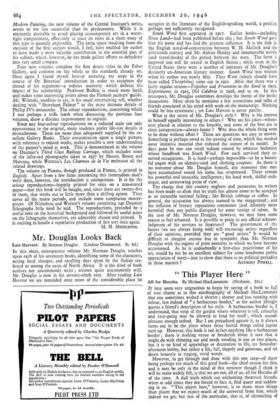Recent Art Books
Our they come for the Christmas market, to be bought for pleasure, for reference, for prestige and snob value, part of the ever-renewed effort to tame art, classify it and make it palatable. Picture-books on painting and the visual arts are probably available today in greater numbers, variety and quality than ever before. The widest and narrowest fields are covered in every degree of detail ; the reproduc- tions—and, after all, we buy such books for the reproductions—may be found in colour, monochrome and every degree of reduction and enlargement. Such a batch as those under review provide a fairly typical cross-section, and it is to be noted that, at least so far as the texts are concerned, the most stimulating are among the lower-priced books.
That Michael Ayrton's essay is provocative and outspoken readers of this journal need hardly be told. The subject is one after his own heart, and he seizes the opportunity to develop a thesis on the native qualities of English draughtsmen with an enthusiasm which is refreshing. The illustrations are admirably chosen, and the book is the more welcome because it fills a gap of long standing. It in no way detracts from Mr. Ayrton's contribution to recall once more how much this series owed to its general editor, the late W. J. Turner. Modern Painting, the new volume of the Central Institute's series, seems to me less successful than its predecessors. While it is eminently desirable to avoid placing contemporary art in a water- tight compartment, effectively to trace its roots in a short essay of this type is patently impossible. The extra space resulting from the excision of the first section would, I feel, have enabled the author to have made a more valuable contribution to the essential part of his subject, which, however, he has made gallant efforts to dehydrate into very small compass.
Four new volumes complete the first dozen titles in the Faber Gallery, and conform on the whole to the standards already set. Once again I found myself forever retracing my steps in the course of Dr. Borenius' introduction in order to recapture the thread of his argument—a tedious necessity which deflects the impact of his scholarship. Professor Bodkin is much more lucid, and makes some interesting points about the Flemish painters' guilds. Mr. Wilenski, needless to say, is his usual entertaining self, whether dealing with " Shoreham Palmer " or the more intimate details of Phillip IV's moustache. The colour reproductions, concerning which I was perhaps a trifle harsh when discussing the previous four volumes, show a distinct improvement in register.
Since any four-colour reproductions on a reduced scale can only approximate to the original, many students prefer life-size details in monochrome. These are more than adequately supplied by the ex- cellent Gallery Books. Their concentration upon a single picture, with reference to related works, makes possible a new understanding of the painter's mind at work. This is demonstrated in the volume on Daumier's Third Class Railway Carriage, which includes some of the infra-red photographs taken in 1937 by Messrs. Rosen and iMarceau, while Watteau's Les Charmes de la Vie embraces all the related drawings.
The volume on Picasso, though produced in France, is printed in English. Apart from a few hints concerning this tremendous man's early days, however, the introduction is unimportant. It is for the colour reproductions—happily printed for once on a non-coated paper—that this book will be bought, and, since there are twenty-five of them, that works out at little more than a shilling apiece. They cover all the major periods, and include some sumptuous master- pieoes. Of Nicholson and Watson's volume containing 240 Daumier lithographs little need be said. The reproductions, preceded by a useful note on the historical background and followed by useful notes on the lithographs themselves, are admirably chosen and printed. It is exciting to handle a superlative production of this sort once again. M. H. MIDDLETON.



































 Previous page
Previous page